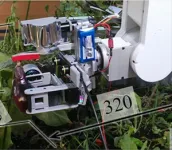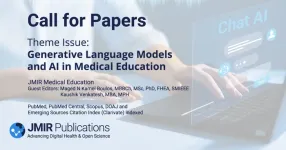(Press-News.org) AMES, IA – In his new book, Matt DeLisi, a world-renowned criminologist at Iowa State University, lays out evidence that Ted Bundy’s criminal career was far lengthier and deadlier than the official record from 1974 to 1978.
“Ted Bundy and the Unsolved Murder Epidemic: The Dark Figure of Crime” underscores how most crime is never known to law enforcement. The book also emphasizes that a small percentage of individuals in society commit a much larger share of violent crime. With an estimated 250,000 to 350,000 unsolved homicide cases in the U.S., DeLisi offers solutions for clearing the backlog and bringing justice to victims and their families.
The Distinguished Professor and College of Liberal Arts and Sciences Dean's Professor says he “learned about Ted Bundy when America did.” As a young boy, DeLisi watched nightly news coverage of Bundy’s crimes, jail escapes and ultimate capture. He was in high school during Bundy's execution in 1989 and his academic interests coincided with the burgeoning true crime genre. With 25 years now as a practitioner, researcher and consultant on violent criminals, DeLisi weaves his expertise with the accounts of people who knew Bundy intimately.
“Bundy drops a lot of clues that there were way more murders than the official victim account of around 30 young women and girls. And the pacing and confidence with which he's killing between 1974 and 1978 indicates there's no way he could have just started. To me, it really reflects someone who had been doing this for years,” says DeLisi.
Throughout the book, DeLisi builds his argument that Bundy’s murder count was likely 100 or more and that his first killing was in adolescence. Stories from people who knew Bundy as a child indicate early signs of his psychopathology. As a three-year-old, Bundy placed knives around his sleeping aunt and watched her until she awoke. He pulled apart mice in the woods, tried to drown others while swimming and boating and stole constantly throughout his life.
DeLisi writes, “He wasn’t some normal, law-abiding citizen who just snapped and went on a murder spree.” In prison, Bundy was diagnosed as a psychopath, and he showed clear signs of sexual sadism among other conditions. Bundy had “no sense of remorse, guilt, embarrassment, or shame for his violent transgressions” and enjoyed hurting others. DeLisi said these disorders – especially the combination – are extremely rare in the general population, but they’re shared by other infamous serial killers of the era, including Samuel Little and Rodney Alcala.
Interstates and technological limitations
One of the chapters, “The Open Road,” explores why unsolved murders increased nearly 80% between 1960 and the early 21st century. The rapid development of highways and interstates made it easier for criminal offenders to find victims and evade detection. Hitchhiking was common, and parents were less concerned with monitoring and surveillance. Without cellphones and GPS, it was much harder to know if someone was missing.
The criminal justice system also struggled with sharing information about wanted subjects and missing persons between jurisdictions and with the public.
“A lot of bordering agencies didn’t know they had murders happening in the other jurisdiction, but there were also petty professional issues with some people not wanting another agency to get involved. Offenders like Ted Bundy knew how to exploit that,” says DeLisi.
Gas receipts in Bundy’s car showed he often drove hundreds, sometimes thousands of miles, even when he was the most wanted man in America. DeLisi writes “for the entirety of Ted Bundy’s offending career, the criminal justice system was woefully underequipped to locate, arrest, detain or frankly, to even identify him.”
The ability to use DNA as evidence would come years after his crime spree, as would the development of the Automated Fingerprint Identification System and National Missing and Unidentified Persons System.
Improvements to criminal justice
DeLisi says the ability to share information and link multiple crimes to an offender is exponentially better and faster today. One of the most important advancements in forensic science technology was the centralized database for DNA samples (Combined DNA Index System or CODIS), which was implemented in 1998. With increases in federal funding over the last two decades, local and state law enforcement agencies have used CODIS to link multiple crimes and solve cases.
A U.S. Supreme Court ruling in 2013 “upheld that the collection of DNA evidence via a buccal or cheek swab is consistent with other evidence gathering procedures during the booking process, such as fingerprinting,” writes DeLisi. But he points out that only 30 states collect a DNA sample when someone is arrested. Other states require probable cause hearings before the sample is either collected or analyzed.
DeLisi says these are “unnecessary judicial impediments.” He adds that some law enforcement agencies are reluctant to submit forensic evidence due to backlogs or insufficient funding for laboratory analysis.
Directing more resources to these agencies and requiring DNA samples at the point of arrest is one of the best ways to catch the worst offenders, says DeLisi. Other innovations in forensic science, like ground penetrating radar, could help find bodies in clandestine burial sites. He says there’s growing awareness around Missing and Murdered Indigenous Women, but the issue of unsolved homicides is still off the radar for many people in the U.S.
“We can and should do more,” says DeLisi. “I've always had a deep-seated appreciation for justice, especially for victims and for public safety, and to me, it’s reprehensible that people have these loved ones who have disappeared and don’t have any resolution.”
Currently, DeLisi is working on another book that focuses on DNA as forensic evidence in cold cases.
END
The dark figure of crime
2023-03-20
ELSE PRESS RELEASES FROM THIS DATE:
JMIR Medical Education invites submissions for its new theme issue "ChatGPT: Generative Language Models and Generative AI in Medical Education"
2023-03-20
JMIR Medical Education is excited to announce the launch of a new theme issue, ChatGPT, Generative Language Models, and Generative AI in Medical Education. The Call for Papers is now open and submissions are due by July 31st.
Guest editors Kaushik P Venkatesh, MBA, MPH, of Harvard Medical School, Boston, MA, USA, and Maged N Kamel Boulos, MBBCh, MSc, PhD, FHEA, SMIEEE, of Sun Yat-sen University, China, are encouraging both empirical and theoretical submissions, including original research, systematic reviews, viewpoints, and tutorials.
The objective of this theme issue ...
Few people seem to find real joy in JOMO
2023-03-20
PULLMAN, Wash. – Most people who ranked high in “joy of missing out” or JOMO also reported high levels of social anxiety in a recent Washington State University-led study.
The term JOMO has been popularized as a healthy enjoyment of solitude in almost direct opposition to the negative FOMO, the “fear of missing out” people may have when seeing others having fun experiences without them. In an analysis of two samples of adults, researchers found mixed results when it comes to JOMO with evidence that there is some anxiety behind the joy.
“In general, a lot of people like being connected,” said ...
Does discrimination accelerate aging in African American cancer survivors?
2023-03-20
Study reveals link between major discrimination and frailty
Cancer and its treatment can accelerate the rate of aging because they both destabilize and damage biological systems in the body. New research published by Wiley online in CANCER, a peer-reviewed journal of the American Cancer Society, found that African American cancer survivors who reported high levels of discrimination exhibited greater aging and frailty than those reporting lower levels of discrimination.
For the study, Jeanne Mandelblatt, MD, MPH, director of the Institute for Cancer and Aging Research at Georgetown University’s Lombardi Comprehensive Cancer Center in Washington, ...
Study finds relationship between discrimination and frailty in Black cancer survivors
2023-03-20
WASHINGTON — Discrimination experienced by Black people can affect their health and increase their frailty, which can be particularly impactful for cancer survivors, according to a new study by researchers at Georgetown University’s Lombardi Comprehensive Cancer Center and colleagues at the Barbara Ann Karmanos Cancer Institute in Detroit. The researchers assessed frailty by a number of factors, including whether a participant had several chronic diseases, poor muscle strength and difficulty performing activities of daily living.
The ...
Underactive immune response may explain obesity link to COVID-19 severity
2023-03-20
Individuals who are obese may be more susceptible to severe COVID-19 because of a poorer inflammatory immune response, say Cambridge scientists.
Scientists at the Cambridge Institute of Therapeutic Immunology and Infectious Disease (CITIID) and Wellcome Sanger Institute showed that following SARS-CoV-2 infection, cells in the lining of the lungs, nasal cells, and immune cells in the blood show a blunted inflammatory response in obese patients, producing suboptimal levels of molecules needed to fight ...
Unrealistic vaping views? Nearly ½ of parents confident they’d know if their child vapes
2023-03-20
Nearly half of parents say they would definitely know if their child was vaping, despite characteristics of vaping devices that make it easy to hide or disguise their use, a new national poll suggests.
Four in five parents also think their adolescent or teen understands the health risks of vaping with few believing their child has tried it, according to the C.S. Mott Children’s Hospital National Poll on Children’s Health at University of Michigan Health.
“Very few parents believe their ...
Changing one’s behavior in different social interactions is child's play
2023-03-20
Society and social interaction play a key role in life for humans. The well-being of a person greatly depends upon their ability to be part of complex socio-cultural institutions. Even during infancy, humans rely on their social interactions with other humans for social and cultural learning, subsequent adaptation to different social environments, and ultimately, survival. Several studies have shown that infants do not respond automatically or reflexively to external cues, but instead adaptively modulate their social behaviors to suit their social context. Gaze-following is one such behavior that infants modulate based on their surroundings. ...
Financial landlords own four times more rental units than previously thought
2023-03-20
New research indicates that a small percentage of financial landlords, like private equity firms and institutional investors, own four times more of Montreal’s rental housing stock than was previously estimated. Neighbourhoods with more financial landlords are also experiencing higher housing stress levels.
In the first comprehensive analysis of its kind in a North American city, researchers from the University of Waterloo and McGill University developed a new method of identifying networks of property ownership lurking behind ...
Multi-drug resistant organisms can be transmitted between healthy dogs and cats and their hospitalised owners
2023-03-19
**Note: the release below is a special early release from the European Congress of Clinical Microbiology & Infectious Diseases (ECCMID 2023, Copenhagen, 15-18 April). Please credit the conference if you use this story**
Embargo: 2301H UK time Saturday 18 March
Healthy dogs and cats could be passing on multidrug-resistant organisms (MDROs; bacteria that resist treatment with more than one antibiotic) to their hospitalised owners, and likewise humans could be transmitting these dangerous microbes to their pets, according to new research being presented ...
New immunotherapy strategies in targeting complexity in the tumor microenvironment
2023-03-18
Alexandria, VA – A symposium aiming to provide a better understanding of the tumor microenvironment, immune tolerogenic niches at cancer initiation, and novel immunotherapeutic strategies in head and neck cancer patients was featured at the 52nd Annual Meeting & Exhibition of the AADOCR, held in conjunction with the 47th Annual Meeting of the CADR. The AADOCR/CADR Annual Meeting & Exhibition took place at the Oregon Convention Center in Portland on March 15-18, 2023.
Cancer ...




